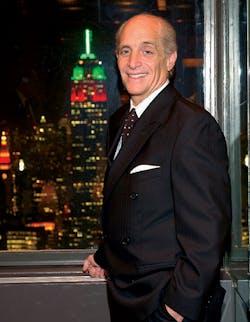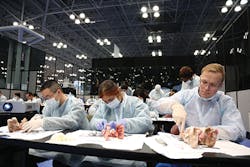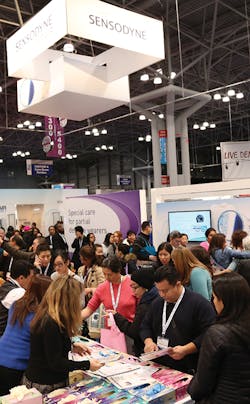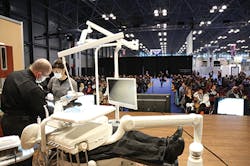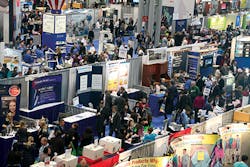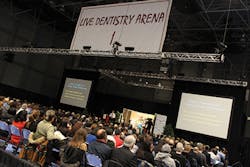An Interview with Robert Edwab, DDS, Executive Director of the Greater New York Dental Meeting
By Chris Salierno, DDS
Have you heard rumors that dental trade shows aren't doing well? I recently had the opportunity to chat with Dr. Robert Edwab, executive director of the Greater New York Dental Meeting (GNYDM) for the past 12 years. He shared his candid thoughts on the current state of dental meetings.
Salierno: Thank you for taking the time to address the readers of Dental Economics. Many of us keep hearing that these are tough times for dental trade shows - declining attendance, unhappy exhibitors, decreasing revenue, and so on. How is the Greater New York Dental Meeting holding up these days?
Edwab: First I would like to thank you, Dr. Salierno, along with Dental Economics, and PennWell Corporation for honoring the Greater New York Dental Meeting with this interview. Contrary to the industry, our meeting is doing well. The most recent statistics indicate both exhibitors and attendees are increasing. Last November, at the conclusion of our 2013 meeting, we registered over 54,000 attendees. They came from all 50 states and 131 countries. That number included over 19,000 dentists. This year, our total registration to date is already up 3%. Not only has the GNYDM grown to be the largest dental event in the United States, it has also simultaneously grown to be the largest health-care event. The GNYDM was recently named by Trade Show Executive magazine to its prestigious "Fastest 50" list of honorees for 2014.
Salierno:Why do you think the GNYDM is doing better than other shows? What's the secret?
Edwab:It really isn't a secret, but basic business principles. First, identify your customers, learn their needs, and provide extraordinary services to them; second, invest in your business; and third, expand on your competitive advantages.
I am also fortunate to have three progressive thinking boards: the Greater New York Dental Meeting Organization Committee and our two sponsoring organizations, the Second District Dental Society (which represents dentists of Brooklyn and Staten Island) and the New York County Dental Society (which represents dentists of Manhattan). Our boards understand that the GNYDM cannot keep growing if it is run like an association where politics take preference over business. Also, the many general chairmen, who each hold two-year terms, have helped in our creativity. All of the support provided by these entities enables us to take this event to the next level each year.
Salierno:How do you still manage to keep exhibitors happy?
Edwab:Simple ... bodies on the exhibit floor. That is why I initially mentioned to you how important it is to identify your customers and to serve them. Exhibitors are the main source of revenue for dental meetings. They should not be taken for granted but supported. At the GNYDM, we eliminated registration fees so attendance would grow. We take a loss in revenue by allowing all attendees, and especially dentists (non-ADA members, ADA members, domestic, and international), into the meeting for free. We decrease available booth space, and again lose revenue, by building classrooms on our exhibit floor, which forces attendees to walk past our exhibitors as they attend classes. Similarly, we strategically place CE computers in the back of the exhibit floor ... so, again, you have to walk to all areas throughout the exhibit floor to register your CE credits.
We feel we have an obligation to create a positive business environment for our exhibitors to succeed. They make an enormous investment and we have an obligation to help them 365 days a year, not just during an annual event, so that they obtain superior returns on their investment. We also maintain an open dialogue with our exhibitors and are always open to new and unique suggestions.
Salierno:What are some of those unique suggestions from exhibitors that have been successful?
Edwab: The goal is to further sales opportunities for our exhibitors. As I previously explained, we limit booth sales by building classrooms. We created a "Live Dentistry Arena" where every morning and afternoon for four days, clinicians are actually treating patients and demonstrating unique procedures. We do implants and cosmetics. One year, we even had Larry Rosenthal prepare eight veneers and insert them the next morning in the arena. It is an incredible learning process where attendees in the 450-seat arena can ask clinicians questions while they are actually working on their patients.
We also partnered with Aegis Publishing and started a laboratory meeting to run on the exhibit floor simultaneously with the GNYDM. The purpose was to improve and increase educational programs for dental technicians. We also wanted to create an open dialogue between technicians and dentists - especially in this digital age.
This year we started a World Implant Expo with four days of seminars and workshops. We partnered with two leading and prestigious implant organizations - the International Congress of Oral Implantologists (ICOI) and the American Academy of Implant Dentistry (AAID). We expanded our four-day Invisalign Expo for new practitioners wanting to incorporate this unique technology into their offices, and have expanded the program to include additional educational opportunities for those previously certified.
One final example: This year we are publishing our own newspaper to advertise programs and list exhibitors and their products to help increase attendance and exhibit floor traffic.
Salierno: What are some common practices with other meetings that the GNYDM chooses not to implement?
Edwab: I have seen other meetings raise the price for educational programs as the meeting approaches and further raise the price on-site. At the GNYDM, the price is always the same for education from the day the program is announced until the day of the program. Why increase the price? Your overhead didn't go up, but you are now penalizing your dentist and auxiliary customers. Plus, if the attendee decides to stay home because of the increased price, you have now penalized the exhibitor. Some meetings raise the price of registration on-site. Others do programs off-site in hotels or at night. Why? This draws attendees away from the exhibit floor and gives them an excuse to go home after the program. Lastly, some dental meetings have excessively high registration fees for nonmembers. Unfortunately, we are witnessing a drop in organized dentistry membership as younger dentists do not see value in joining. We let all dentists into our meeting for free so they can learn, be better health practitioners, and create sales for our exhibitors.
Salierno:If you had asked me who a dental trade show serves, I would have said it was the attendees. But what you're saying makes sense. You seem to have a sharp eye for business.
Edwab:I am currently on an incredible journey. Upon retirement, Jack Welch - the former chairman and CEO of GE, who ran the company for 25 years and expanded it from a $40 billion company to a $400 billion company - started his own certified MBA school, the Jack Welch Management Institute at Strayer University. Each of the 12 courses requires daily online interaction with colleagues and faculty. I am currently in my eighth course and every day I learn something new that can be incorporated into the Greater New York Dental Meeting so it can continue to grow. With the practice of dentistry changing so rapidly from single practitioners to groups to corporate dentistry, an MBA will be a requirement for the business management side.
Salierno: Why do you think these are difficult times for dental trade shows? What set this trend in motion?
Edwab:Now you are going to get me into trouble! We have to go back a number of years for that explanation. The ADA back then had a great idea ... CERP. CERP would ensure quality education for the profession. I applauded them for that initiative. Unfortunately, whether for political reasons, to increase revenue, or just bureaucratic expansion, they expanded it to include commercial enterprises. This opened educational providers from just the ADA, state, and components to now include dental distributors, manufacturers, publications, entrepreneurs, and laboratories. This, I feel, started the process for dentists to avoid local, state, and ADA meetings because they could now obtain their education from other sources.
A few years ago at a conference of dental meetings, I had the opportunity to publicly question the then-chairman of the ADA's CERP Committee. I reminded him how diligently organized dentistry monitors attendance at their programs by scanning attendee badges when they arrived and departed, as well as their use of other unique methods. I then showed him about an inch of saved advertisements of CERP-approved educational programs offered throughout the world and questioned him how he monitors those programs. The reply I received was that CERP is a licensing organization, not a policing organization. So the result is to take educational courses in your office, at home, from a magazine, at an international meeting, on a cruise ship, or from a dental company, but not from an organized dentistry event. Even the ADA broadcasts CERP education 24/7.
This is what I mentioned previously - that young members need value to belong. When I entered dentistry over 35 years ago, only the ADA, my component, and state offered quality educational opportunities. Now CERP-approved education is everywhere in the world.
Another reason some dental trade shows are having challenges is because some meeting planners schedule a meeting in close proximity of time and location to another meeting. This ultimately makes exhibitors choose between two meetings, as it is not cost effective to exhibit in the same region two times within a few weeks. If you treat exhibitors like partners, you would never put them into a situation that decreases their sales and networking opportunities.
Salierno:I can't even imagine what it's like to manage a team large enough to make the Greater New York Dental Meeting operate smoothly.
Edwab: The team we have assembled is incredible. I am pretty loose when it comes to rules, so my team knows that if personal family/children challenges arise, address them immediately. Time can always be made up evenings and weekends. Throughout the year they understand that I would sooner they make a mistake or fail because they tried something new than to not have tried something at all. For the months leading up to the GNYDM, we practice "challenges and contingencies." On-site, where on-the-spot decisions are required, they are allowed to make their own judgments and act without me. The rule is simple: make the best decision as we practiced throughout the year. If it is the right decision, they get the credit. If it happens to be the wrong decision, it is my fault. It is because of them that in the 12 years since I have been executive director, the Greater New York Dental Meeting has grown from a total 38,000 to 55,000 registered attendees; 400 exhibitors to 625; 8,000 dentists to 19,000; 46 states to all 50 states; and attendees from about 60 countries to 131 last year.
Salierno:What do you predict a dental trade show will look like in 10 years?
Edwab:I am optimistic that those with competitive advantages will survive and grow, while others will have to cease or merge. As a dentist (board-certified oral and maxillofacial surgeon), I believe our colleagues buy products after they look, touch, and feel them. Hands-on workshops, exhibit floors, and demonstrations are really the only mechanism to play with the product and then decide to introduce it into your practice. Only at dental meetings can this process occur. Hopefully, the ADA will address the CERP problem and bravely change it to drive attendees back to their dental meeting, which has unfortunately declined from a 50,000 to a 21,000 registered event. It will take leadership and passion to refocus that problem. But for now, each individual dental meeting will have to grow by being innovative with unique programs to demonstrate value for their attendees and ultimately provide extraordinary sales opportunities for its exhibitors.
Robert Edwab, DDS, has been the executive director of the Greater New York Dental Meeting for the past 12 years. Prior to that, he was a board-certified oral and maxillofacial surgeon for 25 years in Brooklyn, New York. He is currently on staff at New York University College of Dentistry. He offers seminars and hands-on workshops on oral surgery for general practitioners at dental meetings throughout the world. He can be contacted at [email protected].

